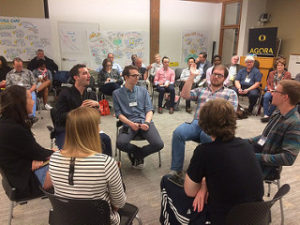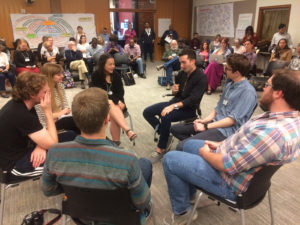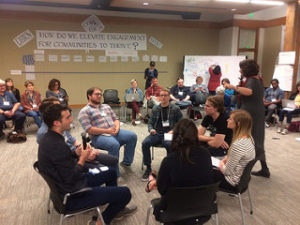Hosted by Alisha Saville and Simon Nyi
Attendees:
Bob Stilger
Andrew Rockway
Lisa Loving
Shawn Poynter
Khari Johnson
Q: How can we start new civic media initiatives that amplify unheard voices in rural areas while building on the work that’s already being done within communities there?
Alisha wants to start a project in Corvallis, OR. Tons of good ideas; people she’s connected with who are totally bought into the idea but not going to be the convener; she has to come in and start the ball rolling. What are ways to do that?
Intros:
Andrew Rockway: Jefferson Center’s mission: how do we create or strengthen opportunities for Americans to participate in civic life?
Democratic deliberation – get a diverse microcosm to learn about things in-depth and come up with their own solutions.
Lisa Loving: writing a book on citizen journalism
Bob Stilger: from Spokane, works for New Stories, nonprofit that does a platform for engagement and people that do good stuff to do their good stuff
Shawn Poynter, Daily Yonder
Khari Johnson – writes for Venturebeat by day, does a project monitoring crowdfunding platforms, Through The Cracks
His community project in Imperial Beach, CA: he leans left, open to ideas from anywhere, most of community was not – the way he got over that was coffee shop newsroom approach – it’s about being available. Eventually people talk to you
Shawn: we call it the Dairy Queen newsroom approach
Khari: the most engaged people are not the whole, but can make a lot of progress to the wider group of people you want to reach
Alisha: Corvallis is a university town that’s half university, half town. Big divide between the groups, not comfortable mingling – big Muslim population that she doesn’t see anywhere except campus – something truly inclusive that’s not just showing off diversity.
Lisa: her dream is teaching everyday people journalism. Trained citizen journalists, plugged them into jobs. She trains these people to do great stuff, but where can they go? Has a dream about University of Washington’s News Lab – would love to see a news service staffed by citizen journalists, relationships with local media that already exist.
Shawn: rural gets blamed a lot for Trump. Here’s The Trump Voter, here’s why he won, when by numbers, more people on Long Island voted for trump than in the whole state of west Virginia
Andrew: trying to find shared narratives between rural and urban communities facing similar challenges of economic inequality, climate change, trying to grapple with finding solutions separately when journalism has a key role to play in developing shared narratives between rural and urban
Alisha: have any of you had experience with a smaller non-metro area? Maybe it’s a homegrown thing. Small group of citizens that have come together around an issue, that’s then spiraled into a more robust local information environment
Lisa: has worked at little newspapers. Not everybody takes in news the same way. Native American communities are traditionally connected to radio. There are great radio stations with fabulous programming that are totally under the radar. Possibly Latinx community as well. Not everyone’s gonna sit there and read the paper. Lots more communities are likely to sit and read their phone. Think about where people are at. Take the temperature. Some people are embattled.
Think about the small businesses that would love to host your event. Small businesses love it when you bring people in
Start with the people you want to serve. What would connect you, make you want to sit in a room with other people?
Khari: In his project in Imperial leaned on local community college freelancers. Also had not been a daily paper or publication in the area. It was showing up at those things. Some newsrooms are working with Facebook Live editorial meetings.
Khari: Engagement doesn’t have to be used to grab old communities, it can be used to build new ones.
Khari: Different groups “met” in the comments section. The two opinions met each other because he was willing to report on whatever
Alisha: Also interested in cultural organizing across communities that already exist. Can media/storytelling performance be one space to do that?
There are a bunch of different communities that exist in Corvallis, there’s a town gown divide with no real community center. If you’re not into sports, how are you going to see people that you don’t self-select for?
Andrew: different approach to producing information: producing narratives, rather than having one journalist try to create a narrative from bits and pieces. Seeing media as a process through which to bring together diverse communities
Rural Minnesota climate change: brought together people that were half deniers, half believers and other differences – what is climate change for our community and what can we do about it? Had them listen to local “experts” – “I don’t think about climate change but I know we’ve had a lot of heavy rainstorms in the last few years”
Do that for a number of critical issues in the community. Have those folks discuss the things they’re seeing, then put in that frame: “I’ve seen this change and didn’t know it was climate change” – ultimately produced a set of recommendations for challenges and opportunities, here are the actions we want to take as a community to do – all their streetlights now are LEDs, they signed a climate protection partnership with a city in Germany that produces renewable energy – shared, co-created document
Getting and maintaining buy-in: pay people and value their time for their work – make sure you can get people in who face barriers to participation, also motivated by the process of connecting with people they don’t interact with – see how much they value their community even though they’re different, they all love a lot of the same things about their community
Situate in context of other partners in the community that are receptive to that
Bob: what I like about what Andrew’s saying/what brought me to this circle: feels like some of the questions being asked by the kind of journalists in this room are the same ones being asked by people who work with/in community
Old style in community engagement was “let’s have a town hall meeting” – that, and also the old style of journalism, neither work anymore. Can they partner in new ways? Journos helping people working on nutrition in the community – can they help people in community figure out how to do that – journalism as a partner in community change, rather than apart from it?
Khari: “shared narrative” has something in common with the idea of the solutions journalism network. Something you could spend 20 years exploring ad nauseam. Different forces in this country that appreciate the shared narrative but it’s a story that’s not always available to us
Shawn: focused on issues that cut across rural communities. But even from town to town, it’s so different. Find those big issues and make them localized to your subject. Part is finding people who live in these tiny communities who can write about their experiences
They’re published by the Center for Rural Strategies; manage the National Rural Assembly (collection of rural nonprofits) – manage/edit citizen journalists
Andrew: liked the Daily Yonder article on SNAP, with story templates.
Shawn: created a big Excel doc, each county had a code attached. Basically like Mad Libs: he wrote a story: members of x county were more/less likely to be on SNAP, here’s the percentage
Andrew: if you look at circulation of all those little orgs you send it to, it’s bigger than the LA Times circulation.
Khari: Pew did a survey of online journalists that found that 40% worked for 20-30 publications, the rest tended to work for pubs that were new and small.
Lisa: issues of connectivity itself. How many people out there actually have the internet? Who’s left
Andrew: community energy survey. How do you map energy poverty in our community?
Andrew: big question. How do you produce local information if you don’t have a local news outlet that’s doing that?
They’re working with newsrooms across Ohio to address the dynamic: issues presidential candidates talked about aren’t the issues people in Ohio talked about
People who don’t have news outlets rely on right-wing media or something that explains their situation, makes them feel like people care about what’s happening even if it’s untrue
Hope is to do community engagement as a way of funneling up those narratives, bring that up to the state level – create a sense of “Portsmouth is not different from Akron” – then how do you get that info back to folks in small towns without long-standing news outlets? What are the mechanisms for people in the communities that are disconnected in a lot of ways?
Newsrooms need to do the hard work of building their audiences again and not try to take the quick fix of putting it on Facebook
Khari: to play devil’s advocate: what if he built a bot to send a news desert 4 stories a week via Facebook?
Knows about using bots to reach people who have low data in their lives, low bandwidth
Alisha: for places that don’t have local news outlets – it’s a lack of some group that can provide context and say “oh we care about you”
Through The Cracks – Crowdfunding and Journalism Facebook page
Lisa: if you were gonna start a platform for civic engagement in a rural area, would you just do it on Facebook?
Khari: you could use a bot with automated communication, with the option to speak to a human
Bob: terminologies: building/engaging community vs. reporting on community
Journalists aren’t gonna build/engage community in their own silos
Andrew: gotta be a balance between distribution/coverage and who’s creating the content, why are they invested in doing that, what does that mean for bringing folks together in their community to do something? It’s about actionable information
Khari: and local is where you can see the results. That’s super important in terms of building citizenship
Alisha: curious about existing arts, theater, music, cultural spaces as avenues for action, as ways to bring together existing communities who don’t connect yet
Bob: one of the most awesome things in engaging people across difference: Cycle Oregon
It’s that combination of traditional journalism and a different way of engaging
Khari: Purple is another one. Started by text, also on FB Messenger. They send messages about the news, then people can talk back to them (a human)
Bob: what takes all of the stuff that’s going on here and gets it to another level?
Khari: heard about a lot of projects that made him think they should be working together
Bob: the fabric is there. How do you use it differently?

 Regina Lawrence opens the day with reflections on yesterday. She felt there was a powerful theme on Friday that needs to be named. About frustration, anger, disillusionment, felt by whole swaths of our society who feel they have been left without a voice, or without an equal voice and they don’t have the opportiunities that others have to be heard, or that they havebeen represented for years over a generation of time. I thought that need to be named, and recognized and acknowledged.
Regina Lawrence opens the day with reflections on yesterday. She felt there was a powerful theme on Friday that needs to be named. About frustration, anger, disillusionment, felt by whole swaths of our society who feel they have been left without a voice, or without an equal voice and they don’t have the opportiunities that others have to be heard, or that they havebeen represented for years over a generation of time. I thought that need to be named, and recognized and acknowledged. appropriate humility that these problems have been created over generations, they won’t be fixed over a weekend.
appropriate humility that these problems have been created over generations, they won’t be fixed over a weekend.